People
Alain Servais Is on a Mission to Make Other Art Collectors Less Boring. It’s Not Going So Well.
A day on the trail of Belgium’s most outspoken—and painting-phobic—art connoisseur.
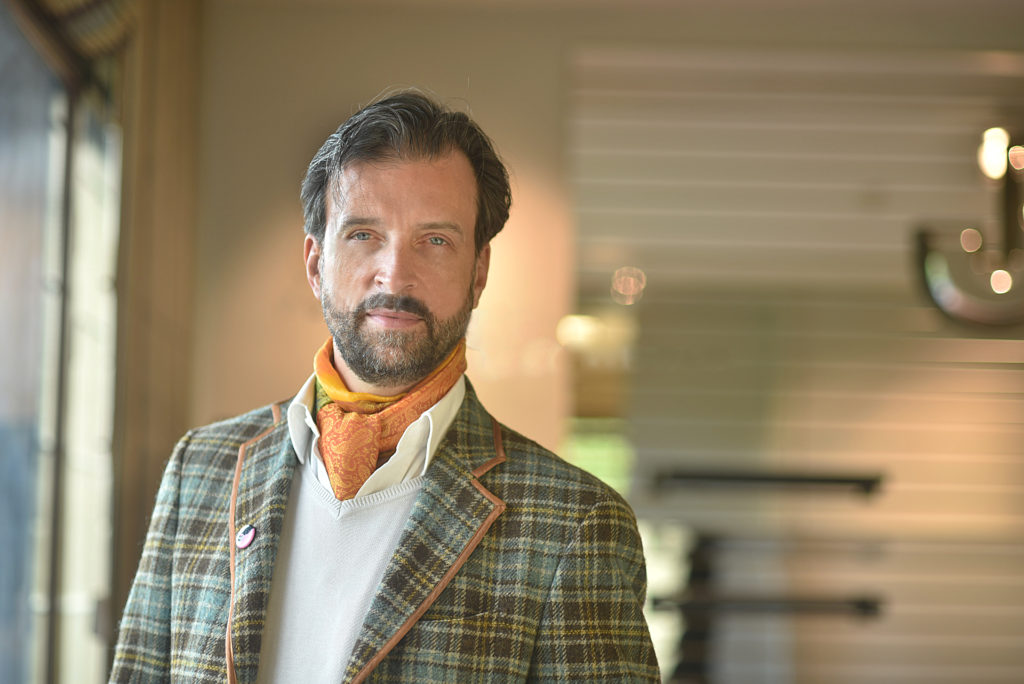
A day on the trail of Belgium’s most outspoken—and painting-phobic—art connoisseur.

Naomi Rea

Less than ten minutes into our meeting, Alain Servais makes his first outfit change of the day. It’s the morning of the VIP preview of Art Brussels, and he has arrived to meet me at the tram station on the foldable bike that is almost as conspicuous in the art world as the outspoken Belgian collector who rides it. (Drop into any European city during a major art event and you are likely to find Servais zipping through narrow back roads from one opening to another on his beloved contraption.)
But however efficient cycling may be during rush hour, it also exposes the rider to passing birds. And their droppings.
Making a pitstop at his home, Servais exchanges his aerially soiled shirt with a crisp white replacement, and dons a pale blue jacket and a pink silk cravat in a self-consciously theatrical fashion.
“Art fairs are like a performance,” laughs his girlfriend of seven years, Eva Ruiz, a former gallerist who now runs her own art consultancy. (The Spanish native, who is 16 years Servais’s junior, apologizes for what she calls her “Penelope Cruz English.”) After the fair preview, the couple will execute a further costume change in the car en route to a collector’s dinner at the Bozar art center.
Alain Servais has been collecting art since 1997—but still expresses the zeal of a new convert. Today, he owns several hundred works by an international roster of artists including Cindy Sherman, Damien Hirst, and David Altmejd. There is no overarching theme to the Servais Family Collection, but it is perhaps best described by what it lacks: painting (the medium of choice of many top collectors) and most of the marquee, blue-chip names that fill auction catalogues.
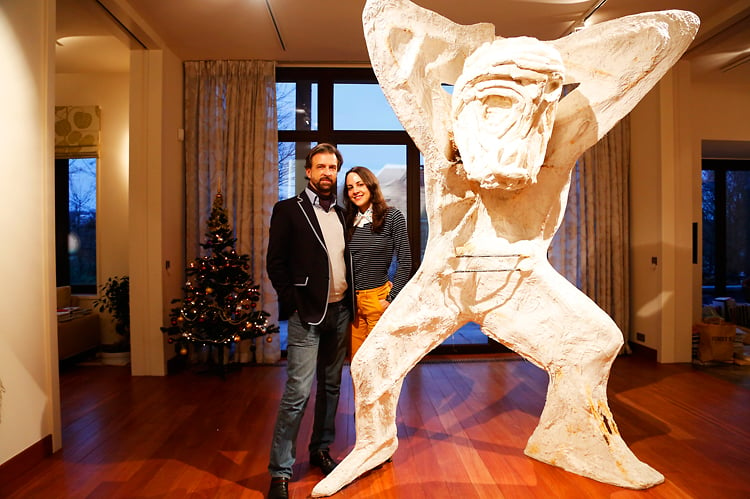
Alain Servais and Eva Ruiz. Photo by Matt Bauwens, courtesy Alain Servais.
Servais takes great pains to distinguish himself from the growing population of blue-chip buyers who seem to collect by numbers, checking off a pre-approved list of names in order to gain access to the social whirl of the art world. At a time when fewer and fewer collectors are willing to take a chance on untested talent, he prefers to buy work early on in an artist’s career, mostly within the $5,000 and $50,000 range.
In Servais’s mind, collecting is less a leisure activity than a kind of solemn duty. It is a collector’s job, he believes, to determine what should be preserved and to act as a custodian of those objects. He decries what he deems the “necrosis of the art market,” in which paintings have become luxury goods par excellence. “I don’t touch painting, even if it’s Picasso,” he insists. (He later clarifies that he wouldn’t turn down a great Picasso, but still wouldn’t touch contemporary painting with a ten-foot pole.)
And while most collectors are content to scout out new buys without competition, Servais is on a self-appointed—and perhaps quixotic—quest to convince others to join him in taking risks.
Like his father, the successful trader Henri Servais, Alain is an investment banker. He draws from his own wallet, as well as a healthy family fund, to support his collecting addiction. Now working as an independent financial consultant, the 54-year-old uses his trend forecasting skills to identify which works he believes will be remembered years down the line.
In order to do this, he contends, it’s important to get outside the art-world bubble. “It pisses me off how little informed the art people are,” he complains. “Even collectors, they have no clue about what’s going on, and I just think, how can you collect?”
This determination to spread important information also drives his ferocious activity on Twitter, where he shares a constant stream of art-world and political news with his 5,000 followers. He can often be found engaging in rapid-fire debates with his critics and seems incapable of letting a piece of criticism go unaddressed.
A frequent sparring partner, the artist William Powhida, often points out despite his professed global outlook, Servais remains insulated by his inherited wealth and the relative safety of Belgium. (In response to a recent tweet by Servais about the fact that there is too much bad art and too much money funding it, Powhida quipped, “This is why public funding for art might be helpful.”)
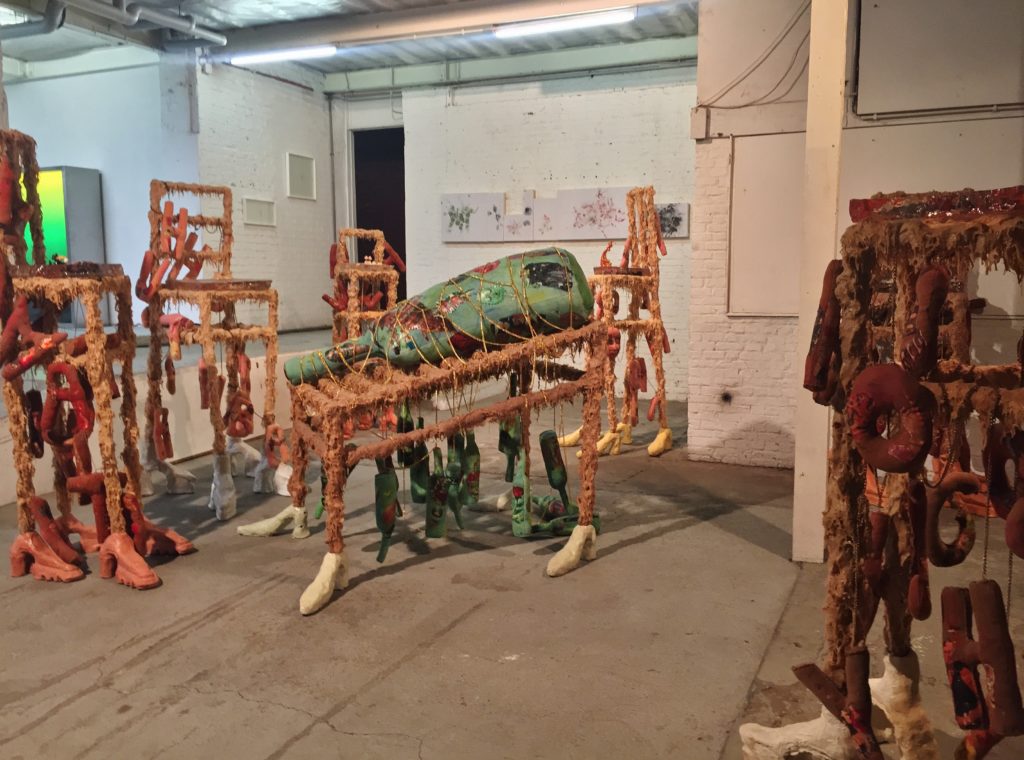
Athena Papadopoulos, The Great Revel of Hairy Harry Who Who: Orgy in the cellar (2015). Exhibition view Servais Family Collection – “Dérapages & Post-Bruises Imaginaries.” In the background from left to right: Guan Xiao, Air Refresher, Spray; Rada Oukova, “Vitrines” series; Tercerunquinto, Paños
Indeed, Servais’s whole project—to encourage collectors to buy cutting-edge art and then make it available to the public, but not necessarily donate it to museums outright—might seem more than a little bit self-aggrandizing. But Sandy Rower, Alexander Calder’s grandson, who has known Servais for almost 20 years, says he doesn’t actually take himself too seriously. “A lot of people misunderstand him,” Rower notes. “They take him to be not smiling, not casual, when in fact he’s all of that: at once incredibly casual, fun-loving, and tremendously serious.”
Their biggest disagreement, he says, is over the fact that New York’s Calder Foundation, of which Rower is president, is not open to the general public.
Since 2010, Servais has kept most of his collection inside a 9,700-square-foot converted factory known as the Loft, located in the Schaerbeek neighborhood, which is home to a large immigrant community. He lived in the industrial space for ten years before moving into a plush house he built in the upscale Uccle area.
During Art Brussels, Servais likes to capitalize on the influx of foreign collectors to proselytize his collecting philosophy. He encourages fellow art enthusiasts to open their own collections to the public and loan out works that would otherwise be in storage. (Servais likes to lend his art not only to museums, but also to friends.)
His holdings are eclectic—and very little is pocket-sized. In the basement, the young Canadian artist Athena Papadopoulos’s The Great Revel of Hairy Harry Who Who: Orgy in the cellar (2015) installation, purchased from the young London gallery Emalin, luxuriates across the floor. On the middle floor, an Emmanuel Van der Auwera video sculpture featuring found footage from predatory drones fills an entire room.
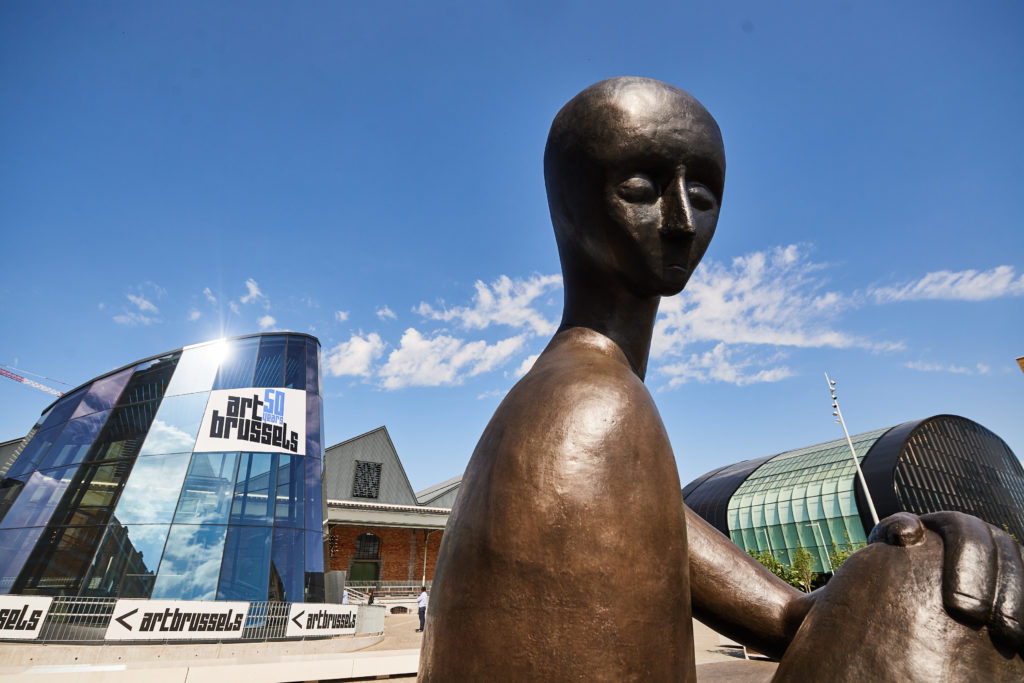
Henk Visch, Das Kino at Art Brussels 2018. Photo by David Plas.
Although Servais is on Art Basel’s Global Patrons Council and maintains a punishing schedule of art-related travel, he says he also makes a point to venture outside of well-worn urban art centers. This year, he’s already hit up Bangladesh for the Dhaka Art Summit and visited Mexico, New York, Madrid, Warsaw, and Milan. His collection reflects this international scope and engages with a wide variety of subjects, from environmental crises to genetic transformation, religion, and gender.
He has a ten-year-old wirehaired Dachshund named George and two daughters, Marie and Alexia, neither of whom share their father’s passion for art. But he has hope for them yet. “At ages 19 and 21, you want to be like everyone else,” he explains, “and of course contemporary art and conformity don’t go together at all.”
Once inside the halls of Art Brussels, Servais makes a beeline for the Discovery section dedicated to young artists and dealers. But he can’t get very far without being stopped by other collectors and gallerists.
Switching between English, French, and Dutch, he and Eva exchange pleasantries with the Delfina Foundation’s director Aaron Cezar, veteran Belgian collector Walter Vanhaerents, and other well-heeled members of the European scene.
Along the way, one gallerist beseeches his advice: Is it a good idea to put a red dot next to a work if it’s sold? Servais declines to offer a decisive answer. On the one hand, he notes, you risk cutting off people’s interest—but on the other, people always want what they can’t have.
Don’t let the even-handedness of his verdict fool you, however: Servais loves offering his opinion. As he trawls the booths, he lets anyone in range know what pisses him off. It’s inexcusably unprofessional when dealers are slow to follow up with a PDF or images of artworks—but also when you catch them on their laptop at a fair. It’s wonderful to meet artists—but dealers shouldn’t use the introduction as a crutch to avoid having to explain a work of art themselves.
“In Belgium, the content is essential,” he says. “If you’re not able to properly explain the content then forget about the sale!”
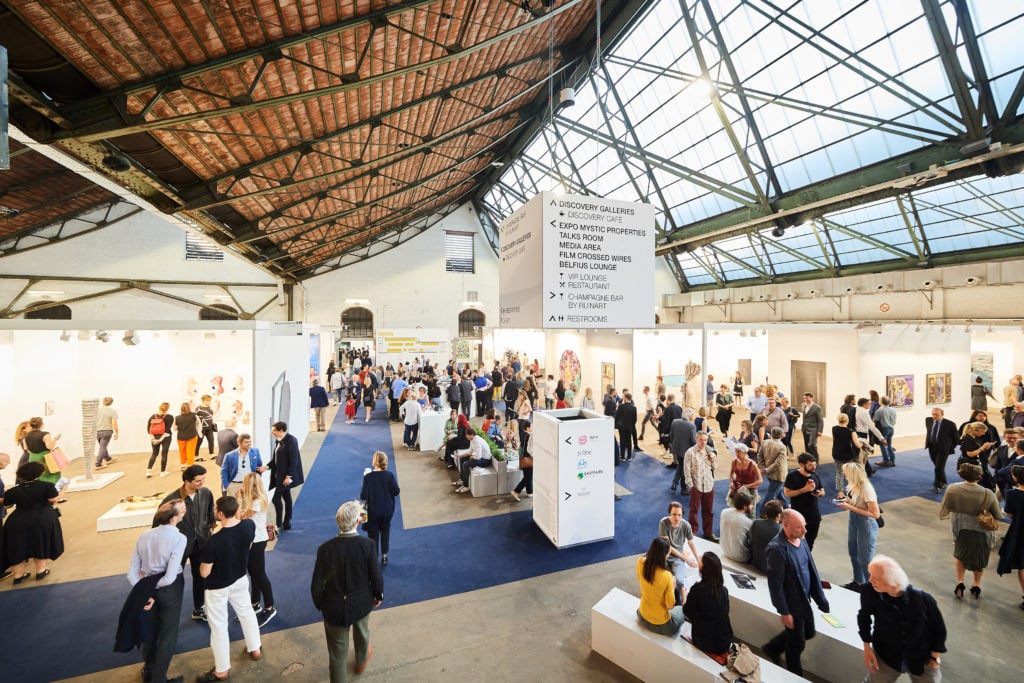
Art Brussels 2018, Tour & Taxis. Photo by David Plas.
At one point, he engages in a spirited discussion about the market for video art with the dealers behind Berlin’s Exile Gallery, Prague’s Polansky Gallery, and the Czech artist Martin Kohout, who recently won the Jindrich Chalupecky Award, the country’s equivalent of the Turner Prize. Servais has emerged as a staunch advocate for stricter terms in the sale of video—arguing, for example, that each one should come with a contract granting the collector the right to display the work publicly. Otherwise, he argues, editioned videos are essentially valueless copies.
“My dear,” he opines, “the copy you’re selling me for €6,000 has got no more rights than a DVD of Titanic that you can only watch officially legally within the circle of the family.” Upon leaving the booth, he emails the group a 15-page essay he has written on the subject.
Servais’s art-world mentors come from a generation of collectors who are now at least 70 years old. One formative moment was an encounter with Herman Daled, the Belgian radiologist who built an impressive collection of conceptual and contemporary art from the ’60s, which he sold to New York’s Museum of Modern Art in 2011.
One piece of Daled’s advice stands out in his memory, Servais says. “When you start collecting contemporary art,” he recalls the collector told him, “the first thing you must let go of is the notion of beauty, because everything that is beautiful is just the accumulated aesthetic.” In 1917, for example, Cubism was nearly universally rejected—so serious collectors are better off choosing art that disturbs them than art that delights them. “That was kind of a shock to hear, because I felt it, and I didn’t know how to express it,” Servais says.
It’s a message he seems to have taken to heart. Joseph Kouli, a fellow art collector, describes his friend Servais as having “no taboo; no limits; no boundaries.”
At Art Brussels, Servais ended up buying an atomic bomb sculpture made with bobbin lace by the emerging Belgian artist Maarten Vanden Eynde from the Belgian gallery Meessen Declercq. When he first expressed an interest in the piece during the VIP preview, it had already sold to someone else, but the sale later fell through.
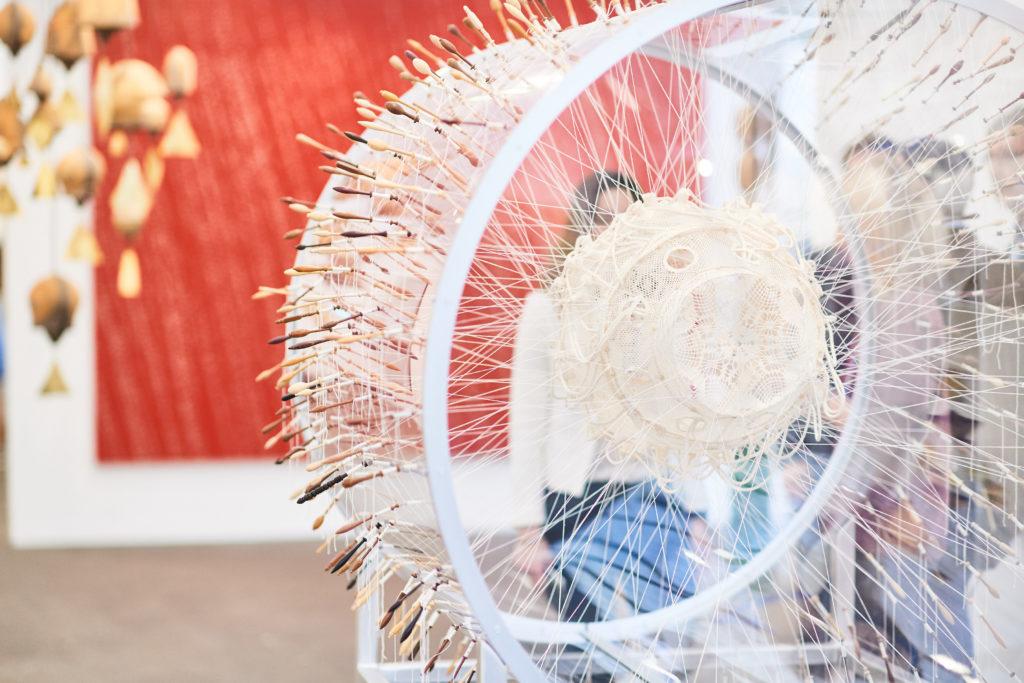
Maarten Vanden Eynde at Meessen De Clercq. ©David Plas.
The remainder of 2018 will see Servais and Ruiz travel to Frieze New York, Arco Lisboa in Portugal, the Riga Biennale in Latvia, the Baltic Triennial in Lithuania, the Berlin Biennale, Manifesta in Sicily, Art Basel in Switzerland, Art-O-Rama in Marseilles, the Code and Chart art fairs in Denmark, the Sao Paulo Biennale, and Fiac in Paris. But the couple also remains open to spontaneous excursions; Eva contends that Servais tries to live a life as disruptive as the art he collects.
After roving the booths for hours, the pair met a group of friends for lunch at Le Pain Quotidien around the corner. Servais ordered a salad, smoked salmon tartines, and a juice. Eager to get back to the fair, he didn’t linger. As he exited the restaurant, he strode over to another table, where the equally jet-setting London-based collector Anita Zabludowicz was enjoying the Belgian heatwave, sunning her face. As he passed by, he slyly offered a piece of entre-nous advice: “You know, if you’re interested in art, there’s an art fair around the corner.”